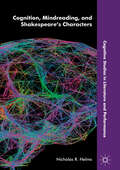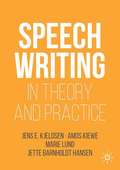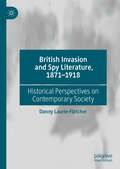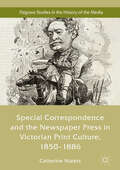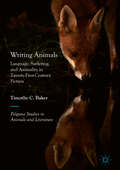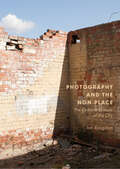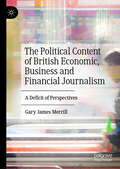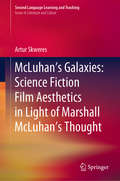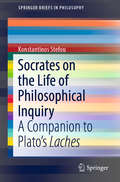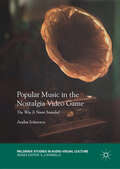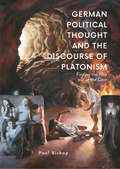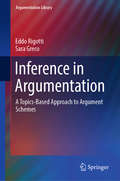- Table View
- List View
Cognition, Mindreading, and Shakespeare's Characters (Cognitive Studies in Literature and Performance)
by Nicholas R. HelmsCognition, Mindreading, and Shakespeare's Characters brings cognitive science to Shakespeare, applying contemporary theories of mindreading to Shakespeare’s construction of character. Building on the work of the philosopher Alvin Goldman and cognitive literary critics such as Bruce McConachie and Lisa Zunshine, Nicholas Helms uses the language of mindreading to analyze inference and imagination throughout Shakespeare’s plays, dwelling at length on misread minds in King Lear, Much Ado About Nothing, Othello, and Romeo and Juliet. Shakespeare manipulates the mechanics of misreading to cultivate an early modern audience of adept mindreaders, an audience that continues to contemplate the moral ramifications of Shakespeare’s characters even after leaving the playhouse. Using this cognitive literary approach, Helms reveals how misreading fuels Shakespeare’s enduring popular appeal and investigates the ways in which Shakespeare’s characters can both corroborate and challenge contemporary cognitive theories of the human mind.
The Representation of Genocide in Graphic Novels: Considering the Role of Kitsch (Palgrave Studies in Comics and Graphic Novels)
by Laurike in 't VeldThis book mobilises the concept of kitsch to investigate the tensions around the representation of genocide in international graphic novels that focus on the Holocaust and the genocides in Armenia, Rwanda, and Bosnia. In response to the predominantly negative readings of kitsch as meaningless or inappropriate, this book offers a fresh approach that considers how some of the kitsch strategies employed in these works facilitate an affective interaction with the genocide narrative. These productive strategies include the use of the visual metaphors of the animal and the doll figure and the explicit and excessive depictions of mass violence. The book also analyses where kitsch still produces problems as it critically examines depictions of perpetrators and the visual and verbal representations of sexual violence. Furthermore, it explores how graphic novels employ anti-kitsch strategies to avoid the dangers of excess in dealing with genocide. The Representation of Genocide in Graphic Novels will appeal to those working in comics-graphic novel studies, popular culture studies, and Holocaust and genocide studies.
Speechwriting in Theory and Practice (Rhetoric, Politics and Society)
by Jens E. Kjeldsen Amos Kiewe Marie Lund Jette Barnholdt HansenThis book provides students, researchers, and practitioners of speechwriting with a unique insight in the theory, history, and practice of speechwriting. The combination of theory and practice with case studies from the United States and Europe makes this volume the first of its kind. The book offers an overview of the existing research and theory, analysing how speeches are written in political and public life, and paying attention to three central subjects of contemporary speechwriting: convincing characterization of the speaker, writing for the ear, and appealing with words to the eye. Chapters address the ethics and the functions of speechwriting in contemporary society and also deliver general instructions for the speechwriting process. This book is recommended reading for professional speechwriters wishing to expand their knowledge of the rhetorical and theoretical underpinnings of speechwriting, and enables students and aspiring speechwriters to gain an understanding of speechwriting as a profession.
Hamlet and Emotions (Palgrave Shakespeare Studies)
by R. S. White Paul Megna Bríd PhillipsThis volume bears potent testimony, not only to the dense complexity of Hamlet’s emotional dynamics, but also to the enduring fascination that audiences, adaptors, and academics have with what may well be Shakespeare’s moodiest play. Its chapters explore emotion in Hamlet, as well as the myriad emotions surrounding Hamlet’s debts to the medieval past, its relationship to the cultural milieu in which it was produced, its celebrated performance history, and its profound impact beyond the early modern era. Its component chapters are not unified by a single methodological approach. Some deal with a single emotion in Hamlet, while others analyse the emotional trajectory of a single character, and still others focus on a given emotional expression (e.g., sighing or crying). Some bring modern methodologies for studying emotion to bear on Hamlet, others explore how Hamlet anticipates modern discourses on emotion, and still others ask how Hamlet itself can complicate and contribute to our current understanding of emotion.
British Invasion and Spy Literature, 1871–1918: Historical Perspectives on Contemporary Society
by Danny Laurie-FletcherThis book examines British invasion and spy literature and the political, social, and cultural attitudes that it expresses. This form of literature began to appear towards the end of the nineteenth century and developed into a clearly recognised form during the Edwardian period (1901-1914). By looking at the origins and evolution of invasion literature, and to a lesser extent detective literature, up to the end of World War I, Danny Laurie-Fletcher utilises fiction as a window into the mind-set of British society. There is a focus on the political arguments embedded within the texts, which mirrored debates in wider British society that took place before and during World War I – debates about military conscription, immigration, spy scares, the fear of British imperial decline, and the rise of Germany. These debates and topics are examined to show what influence they had on the creation of the intelligence services, MI5 and MI6, and how foreigners were perceived in society.
Special Correspondence and the Newspaper Press in Victorian Print Culture, 1850–1886 (Palgrave Studies in the History of the Media)
by Catherine WatersThis book analyses the significance of the special correspondent as a new journalistic role in Victorian print culture, within the context of developments in the periodical press, throughout the second half of the nineteenth century. Examining the graphic reportage produced by the first generation of these pioneering journalists, through a series of thematic case studies, it considers individual correspondents and their stories, and the ways in which they contributed to, and were shaped by, the broader media landscape. While commonly associated with the reportage of war, special correspondents were in fact tasked with routinely chronicling all manner of topical events at home and abroad. What distinguished the work of these journalists was their effort to ‘picture’ the news, to transport readers imaginatively to the events described. While criticised by some for its sensationalism, special correspondence brought the world closer, shrinking space and time, and helping to create our modern news culture.
Animal Visions: Posthumanist Dream Writing (Palgrave Studies in Animals and Literature)
by Susan Mary PykeAnimal Visions considers how literature responds to the harms of anthropocentricism, working with Emily Brontë’s Wuthering Heights (1847) and various adaptations of this canonistic novel to show how posthumanist dream writing unsettles the privileging of the human species over other species. Two feminist and post-Freudian responses, Kathy Acker’s poem “Obsession” (1992) and Anne Carson’s “The Glass Essay” (1997) most strongly extend Brontë’s dream writing in this direction. Building on the trope of a ludic Cathy ghost who refuses the containment of logic and reason, these and other adaptations offer the gift of a radical peri-hysteria. This emotional excess is most clearly seen in Kate Bush’s music video “Wuthering Heights” (1978) and Peter Kosminsky’s film Wuthering Heights (1992). Such disturbances make space for a moor love that is particularly evident in Jane Urquhart’s novel Changing Heaven (1989) and, to a lesser extent Sylvia Plath’s poem, “Wuthering Heights” (1961). Brontë’s Wuthering Heights and its most productive afterings make space for co-affective relations between humans and other animal beings. Andrea Arnold’s film Wuthering Heights (2011) and Luis Buñuel’s Abismos de Pasión (1954) also highlight the rupturing split gaze of non-acting animals in their films. In all of these works depictions of intra-active and entangled responses between animals show the potential for dynamic and generative multispecies relations, where the human is one animal amongst the kin of the world.
Writing Animals: Language, Suffering, and Animality in Twenty-First-Century Fiction (Palgrave Studies in Animals and Literature)
by Timothy C. BakerThis book surveys a broad range of contemporary texts to show how representations of human-animal relations challenge the anthropocentric nature of fiction. By looking at the relation between language and suffering in twenty-first-century fiction and drawing on a wide range of theoretical approaches, Baker suggests new opportunities for exploring the centrality of nonhuman animals in recent fiction: writing animal lives leads to new narrative structures and forms of expression. These novels destabilise assumptions about the nature of pain and vulnerability, the burden of literary inheritance, the challenge of writing the Anthropocene, and the relation between text and image. Including both well-known authors and emerging talents, from J.M. Coetzee and Karen Joy Fowler to Sarah Hall, Alexis Wright, and Max Porter, and texts from experimental fiction to work for children, Writing Animals offers an original perspective on both contemporary fiction and the field of literary animal studies.
Shakespeare and the 99%: Literary Studies, the Profession, and the Production of Inequity
by Sharon O’Dair Timothy FranciscoThrough the discursive political lenses of Occupy Wall Street and the 99%, this volume of essays examines the study of Shakespeare and of literature more generally in today’s climate of educational and professional uncertainty. Acknowledging the problematic relationship of higher education to the production of inequity and hierarchy in our society, essays in this book examine the profession, our pedagogy, and our scholarship in an effort to direct Shakespeare studies, literary studies, and higher education itself toward greater equity for students and professors. Covering a range of topics from diverse positions and perspectives, these essays confront and question foundational assumptions about higher education, and hence society, including intellectual merit and institutional status. These essays comprise a timely conversation critical for understanding our profession in “post-Occupy” America.
Photography and the Non-Place: The Cultural Erasure of the City
by Jim BrogdenThis book presents a critical and aesthetic defence of “non-place” as an act of cultural reclamation. Through the restorative properties of photography, it re-conceptualises the cultural significance of non-place. The non-place is often referred to as “wasteland”, and is usually avoided. The sites investigated in this book are located where access and ownership are often ambiguous or in dispute; they are places of cultural forgetting. Drawing on the author’s own photographic research-led practice, as well as material from photographers such as Ed Ruscha, Joel Sternfeld and Richard Misrach, this study employs a deliberately allusive intertexuality to offer a unique insight into the contested notions surrounding landscape representation. Ultimately, it argues that the non-place has the potential to reveal a version of England that raises questions about identity, loss, memory, landscape valorisation, and, perhaps most importantly, how we are to arrive at a more meaningful place.
The Political Content of British Economic, Business and Financial Journalism: A Deficit of Perspectives
by Gary James MerrillThis book assesses the extent to which British news organizations gave exposure and credence to different political interpretations of economics and business news in the decade before the 2008 Financial Crisis. Through the content analysis of some 1,600 news items, this study provides compelling empirical evidence to inform often theoretical debates about neoliberal assumptions in the media. In each of the three pre-2008 case studies – economic globalization, private finance and public services, and Tesco – Merrill finds that the Telegraph, The Times, the Sunday Times and, to varying extents, the Guardian-Observer and the BBC gave limited exposure and credence to ideas from the left of the political spectrum. As such, he builds an important comparative picture of economic, business and financial journalism in the period before the defining event of the decade, the effects of which continue to resonate.
Interactive Storytelling: 11th International Conference on Interactive Digital Storytelling, ICIDS 2018, Dublin, Ireland, December 5–8, 2018, Proceedings (Lecture Notes in Computer Science #11318)
by Rebecca Rouse Hartmut Koenitz Mads HaahrThis book constitutes the refereed proceedings of the 11th International Conference on Interactive Digital Storytelling, ICIDS 2018, held in Dublin, Ireland, in December 2018. The 20 revised full papers and 16 short papers presented together with 17 posters, 11 demos, and 4 workshops were carefully reviewed and selected from 56, respectively 29, submissions. The papers are organized in the following topical sections: the future of the discipline; theory and analysis; practices and games; virtual reality; theater and performance; generative and assistive tools and techniques; development and analysis of authoring tools; and impact in culture and society.
McLuhan’s Galaxies: Science Fiction Film Aesthetics in Light of Marshall McLuhan’s Thought (Second Language Learning and Teaching)
by Artur SkweresThis groundbreaking book uses observations made by Marshall McLuhan to analyze the aesthetics of science fiction films, treating them as visual metaphors or probes into the new reality dominated by electronic media: - it considers the relations between the senses and sensuality in Blade Runner, the visually-tactile character of the film, and the status of replicants as humanity’s new clothes; - it analyzes the mixture of Eastern and Western aesthetics in Star Wars, analyzing Darth Vader as a combination of the literate and the tribal mindset; - it discusses the failure of visual society presented in the Terminator and Alien franchises, the rekindling of horror vacui, tribalism, and the desire to obliterate the past as a result of the simultaneity of the acoustic space; - finally, the book discusses the Matrix trilogy and Avatar as being deeply related in terms of the growing importance of tactility, easternization, tribalization, as well as connectivity and the implosion of human civilization.
Coleridge's Dejection Ode (Nineteenth-Century Major Lives and Letters)
by J.C.C. MaysColeridge's Dejection Ode completes J.C.C. Mays’ analysis of Coleridge’s poetry, following Coleridge’s Ancient Mariner (Palgrave 2016) and Coleridge’s Experimental Poetics (Palgrave 2013). "Dejection: An Ode" stands alone in Coleridge's oeuvre: written at a time of personal crisis, it reaches far back and deeply into his thinking in an attempt to find a poematic solution to ideas and problems he had mulled over for a long time. Mays reveals how the poem also marks the opening of the second half of Coleridge's career as both poet and thinker. In three central chapters Mays examines the new style that evolved in the process of writing the Ode: the technical means of metrics, rhyme and grammar; language and allusion; and symbol and structure. He recounts the complex, sometimes controversial critical history of the Ode, and suggests an editorial solution to the problem created by the Letter to Sara Hutchinson; re-evaluates the position of Wordsworth in the poem apropos the political statement it makes; clarifies the distinction between the views on Imagination expressed and those contained in Biographia Literaria; and traces the links of the concept "dejection" as it underpins Coleridge's late poems.
Topographies of Caribbean Writing, Race, and the British Countryside (Geocriticism and Spatial Literary Studies)
by Joanna JohnsonHow do Caribbean writers see the British countryside? Do they feel included, ignored, marginalised? In Topographies of Caribbean Writing, Race, and the British Countryside, Joanna Johnson shows how writers like Derek Walcott, V.S. Naipaul, Jean Rhys, Grace Nichols, Andrea Levy, and Caryl Phillips have very different and unexpected responses to this rural space. Johnson demonstrates how Caribbean writing shows greater complexity and wider significance than accounts and understandings of the British countryside have traditionally admitted; at the same time, close examination of these works illustrates that complexity and ambiguity remain an essential part of these authors’ relationships with the British countrysides of their colonial or postcolonial imaginations. This study examines accepted norms and raises questions about urgent issues of belonging, Britishness, and Commonwealth identity.
Socrates on the Life of Philosophical Inquiry: A Companion To Plato's Laches (SpringerBriefs in Philosophy)
by Konstantinos StefouThis book offers the first systematic reading of Plato’s Laches in English after three decades of scholarly silence. It rekindles interest in this much-neglected dialogue by providing a fresh discussion of the major issues that arise from the text. Among these issues, pride of place is taken by the virtue of courage, for the definition of which Socrates is depicted as engaging in some long-winded dialectical exchange with his interlocutors. Yet, although there is no room for doubt that the Laches is Plato’s most explicit treatment of courage, this dialogue ends in perplexity and is thus traditionally thought of as an unsuccessful attempt to define what courage is. The present study challenges this suggestion. This book proposes a new paradigm for the interpretation of Plato’s Laches. In fact, it constitutes the first systematic attempt to study the dialogue in light of the idea that its composition could well have formed part of Plato’s overall plan to establish a well-defined and rigorous justification of the life of philosophical inquiry The book will be of key interest to classicists, philosophers, and intellectual historians, but will also appeal to students or anyone interested in ancient Greek philosophy.
Popular Music in the Nostalgia Video Game: The Way It Never Sounded (Palgrave Studies in Audio-Visual Culture)
by Andra IvănescuThis book looks at the uses of popular music in the newly-redefined category of the nostalgia game, exploring the relationship between video games, popular music, nostalgia, and socio-cultural contexts. History, gender, race, and media all make significant appearances in this interdisciplinary work, as it explores what some of the most critically acclaimed games of the past two decades (including both AAA titles like Fallout and BioShock, and more cult releases like Gone Home and Evoland) tell us about our relationship to our past and our future. Appropriated music is the common thread throughout these chapters, engaging these broader discourses in heterogeneous ways. This volume offers new perspectives on how the intersection between popular music, nostalgia, and video games, can be examined, revealing much about our relationship to the past and our hopes for the future.
Developing Enterprise Chatbots: Learning Linguistic Structures
by Boris GalitskyA chatbot is expected to be capable of supporting a cohesive and coherent conversation and be knowledgeable, which makes it one of the most complex intelligent systems being designed nowadays. Designers have to learn to combine intuitive, explainable language understanding and reasoning approaches with high-performance statistical and deep learning technologies. Today, there are two popular paradigms for chatbot construction:1. Build a bot platform with universal NLP and ML capabilities so that a bot developer for a particular enterprise, not being an expert, can populate it with training data;2. Accumulate a huge set of training dialogue data, feed it to a deep learning network and expect the trained chatbot to automatically learn “how to chat”. Although these two approaches are reported to imitate some intelligent dialogues, both of them are unsuitable for enterprise chatbots, being unreliable and too brittle.The latter approach is based on a belief that some learning miracle will happen and a chatbot will start functioning without a thorough feature and domain engineering by an expert and interpretable dialogue management algorithms.Enterprise high-performance chatbots with extensive domain knowledge require a mix of statistical, inductive, deep machine learning and learning from the web, syntactic, semantic and discourse NLP, ontology-based reasoning and a state machine to control a dialogue. This book will provide a comprehensive source of algorithms and architectures for building chatbots for various domains based on the recent trends in computational linguistics and machine learning. The foci of this book are applications of discourse analysis in text relevant assessment, dialogue management and content generation, which help to overcome the limitations of platform-based and data driven-based approaches.Supplementary material and code is available at https://github.com/bgalitsky/relevance-based-on-parse-trees
English After RP: Standard British Pronunciation Today
by Geoff LindseyThis book concisely describes ways in which today's standard British English speech differs from the upper-class accent of the last century, Received Pronunciation, which many now find old-fashioned or even comic. In doing so it provides a much-needed update to the existing RP-based descriptions by which the sound system of British English is still known to many around the world.The book opens with an account of the rise and fall of RP, before turning to a systematic analysis of the phonetic developments between RP and contemporary Standard Southern British (SSB) in vowels, consonants, stress, connected speech and intonation. Topics covered include the anti-clockwise vowel shift, the use of glottal stops, 'intrusive r', vocal fry and Uptalk. It concludes with a Mini Dictionary of well over 100 words illustrating the changes described throughout the book, and provides a chart of updated IPA vowel symbols.This book is an essential resource for anyone interested in British pronunciation and sound change, including academics in phonetics, phonology, applied linguistics and English language; trainers of English teachers; English teachers themselves; teachers of voice and accent coaches; and students in those areas.
Gender Approaches in the Translation Classroom: Training the Doers
by Marcella De Marco Piero TotoThis volume examines strategies for embedding gender awareness within translation studies and translator training programmes. Drawing on a rich collection of theoretically-informed case studies, its authors provide practical advice and examples on implementing gender-inclusive approaches and language strategies in the classroom. It focuses on topics including, how to develop gender-inclusive practices to challenge students’ attitudes and behaviours; whether there are institutional constraints that prevent trainers from implementing non-heteronormative practices in their teaching; and how gender awareness can become an everyday mode of expression. Positioned at the lively interface of gender and translation studies, this work will be of interest to practitioners and scholars from across the fields of linguistics, education, sociology and cultural studies.
The Semantics of Plurals, Focus, Degrees, and Times: Essays in Honor of Roger Schwarzschild
by Daniel Altshuler Jessica RettThis volume is a tribute to Roger Schwarzschild's immense contributions in the formal semantics of nouns, focus, degrees and space, and tense and aspect. Collectively, the papers in the volume reveal parallels across ontological domains, in particular in the context of elements with internal structure, like plural sets, alternative sets, degree intervals, temporal intervals, and vectors. This research suggests that the structure of an entity could inform the semantic behavior of that entity just as much (if not more) than its semantic type or lexical category. And because these structures dictate the formation of semantic alternatives, it can help inform focus semantics and scalar implicature as well. Old questions on plurals, focus and degree expressions get new answers in this collection of papers in honor of Roger Schwarzchild. Roger Schwarzschild is one of the leading scholars in semantics, and the editors have been highly successful in requesting contributions by his teachers, peers and former students. Some papers have circulated in draft form for many years, and find their final home in this edited volume, which well reflects the state of the art in the field. Prof. dr. Henriëtte de Swart, Utrecht University, The Netherlands
German Political Thought and the Discourse of Platonism: Finding the Way Out of the Cave
by Paul BishopTaking Plato’s allegory of the cave as its starting-point, this book demonstrates how later European thinkers can be read as a reaction and a response to key aspects of this allegory and its discourse of enchainment and liberation. Focusing on key thinkers in the tradition of European (and specifically German) political thought including Kant, Marx, Hegel, Nietzsche, Heidegger, and the Frankfurt School, it relates them back to such foundational figures as Rousseau, Aristotle, and in particular Plato. All these thinkers are considered in relation to key passages from their major works, accompanied by an explanatory commentary which seeks to follow a conceptual and imagistic thread through the labyrinth of these complex, yet fascinating, texts. This book will appeal in particular to scholars of political theory, philosophy, and German language and culture.
Inference in Argumentation: A Topics-based Approach To Argument Schemes (Argumentation Library #34)
by Eddo Rigotti Sara GrecoThis book investigates the role of inference in argumentation, considering how arguments support standpoints on the basis of different loci. The authors propose and illustrate a model for the analysis of the standpoint-argument connection, called Argumentum Model of Topics (AMT). A prominent feature of the AMT is that it distinguishes, within each and every single argumentation, between an inferential-procedural component, on which the reasoning process is based; and a material-contextual component, which anchors the argument in the interlocutors’ cultural and factual common ground. The AMT explains how these components differ and how they are intertwined within each single argument. This model is introduced in Part II of the book, following a careful reconstruction of the enormously rich tradition of studies on inference in argumentation, from the antiquity to contemporary authors, without neglecting medieval and post-medieval contributions. The AMT is a contemporary model grounded in a dialogue with such tradition, whose crucial aspects are illuminated in this book.
Complexity Applications in Language and Communication Sciences
by Albert Bastardas-Boada Gemma Bel-Enguix Àngels Massip-BonetThis book offers insights on the study of natural language as a complex adaptive system. It discusses a new way to tackle the problem of language modeling, and provides clues on how the close relation between natural language and some biological structures can be very fruitful for science. The book examines the theoretical framework and then applies its main principles to various areas of linguistics. It discusses applications in language contact, language change, diachronic linguistics, and the potential enhancement of classical approaches to historical linguistics by means of new methodologies used in physics, biology, and agent systems theory. It shows how studying language evolution and change using computational simulations enables to integrate social structures in the evolution of language, and how this can give rise to a new way to approach sociolinguistics. Finally, it explores applications for discourse analysis, semantics and cognition.
Form-Function Mapping in Content-Based Language Teaching: A Study of Interlanguage Restructuring (Second Language Learning and Teaching)
by Magdalena WalentaThis book presents a form-function mapping (FFM) model for balancing language and content gains within content-based language teaching (CBLT). It includes a theoretical part, which outlines the FFM model and, drawing on the analysis of eclectic teaching methods and interlanguage restructuring, proposes pedagogical tools for its implementation. These tools, which encourage mapping of language forms onto content knowledge, are hypothesized to facilitate interlanguage restructuring, thus helping CBLT learners in their struggle with L2 morpho-syntax. The empirical section presents the results of a quantitative–qualitative study conducted among adult L1 Polish learners of English in a CBLT context. It then goes on to translate the findings, which reveal that the FFM model has a positive and significant influence on interlanguage restructuring as well as a favorable reception among CBLT learners, into a set of pedagogical guidelines for practitioners.
